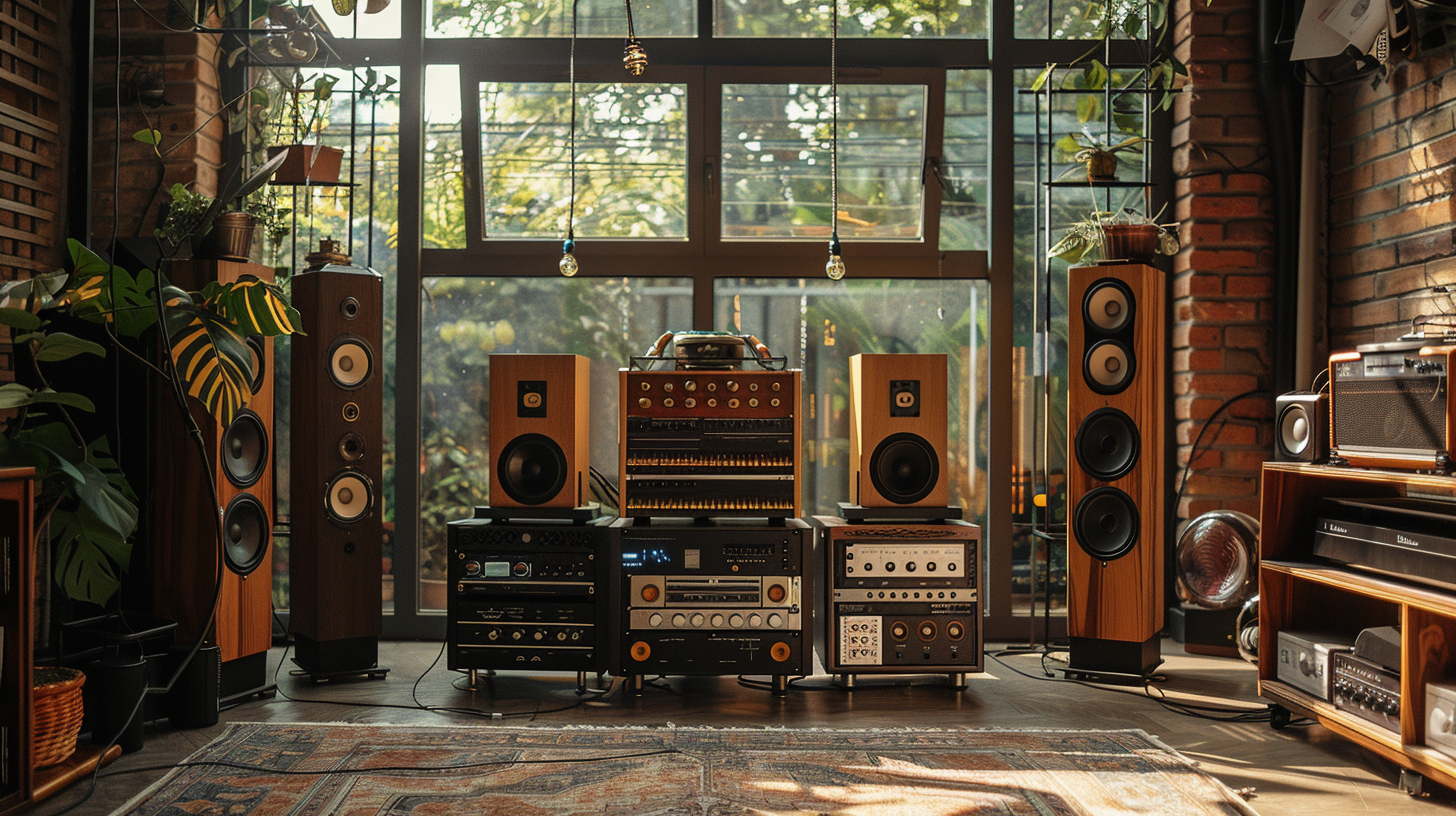Lamp friendly speakers
What helps the speaker make friends with the lamp?
Many of our customers are lamp enthusiasts (or budding lamp fans), so one of the most common questions we get asked is, "Will my speakers work with lamps?" Some buyers are confused, while others are clearly misinformed about what speaker features mean by a "lamp-friendly" design. We were unable to find a good summary of these characteristics on the Internet, and as a result we decided to write one ourselves. This article provides a basic explanation of why some speakers work well with tube amplifiers and others do not.
Overcoming misinformation
One misleading specification that is often presented to our customers is sensitivity. This specification is usually misrepresented as "efficiency", which it most certainly is not. Speakers are terribly inefficient, and it is likely that virtually no consumer is familiar with the actual efficiency specification. The most efficient speaker designed to date was the Altec Lansing Voice of Theatre, which had an efficiency rating of approximately 3.6%. No manufacturer will ever publish an efficiency specification because it would discourage and mislead consumers. But be sure of one thing: sensitivity and efficiency are not the same thing. Even with a transistor amplifier, you can't equate high sensitivity with high efficiency - the physics are actually more complicated than many manufacturers and, unfortunately, reviewers seem to believe.
Instead of efficiency, speaker manufacturers provide sensitivity parameters. This figure is supposed to indicate how loud a speaker will play when powered by one watt of power, or 2.83 volts, when listening at a distance of one meter. The problem with this measurement is that the conditions under which it is made are not clearly defined, and therefore do not provide a constant point of reference. For example, the input sensitivity (gain) of the amplifier used for this measurement is unknown and undefined. Equally important, the value is specified for a distance of one meter, but the specific listening room conditions are not defined. It is not clear whether the measurement took place in an anechoic chamber, concert hall, checkroom, or gymnasium.
The most important lesson to be learned from the above discussion is that whether a tube is right for you or not has nothing to do with sensitivity. Many tube gurus insist that you must use speakers with a sensitivity level of 90dB or higher. This is simply not true. Many high-sensitivity speakers are poor choices for tube amplifiers, while many low-sensitivity speakers often work quite well. Why is this the case? Read more...
Impedance, phase angles and inverse electromotive force... Oh my!
What is impedance
Impedance (for the purposes of this discussion) can be thought of as the variable equivalent of a constant resistance. As a result, Ohm's law applies: in a circuit, the product of resistance and current is the voltage (conventionally represented as V = I x R), which in the case of a speaker-amplifier circuit is constant. In other words, when the resistance increases, the current required from the amplifier to maintain the voltage in the circuit decreases. More importantly, when the resistance decreases, the current required increases. This concept is important for both tube and transistor amplifiers, which will be explained in more detail later.
Virtually all manufacturers publish nominal impedance values for their speakers. The term "nominal" is intended to indicate the optimistic and relatively unscientific nature of the value presented. Many speakers are rated at 8 ohms, but their impedance varies widely over the audible frequency range. It is not enough to know the nominal impedance to determine how well a speaker will work with a tube. Many tube enthusiasts claim that a speaker must be rated at 8 ohms or higher to be "friendly" with a tube - this is a simplification, we'll explain it later. Remember, the impedance rating is only a useful indicator in the context of minimum impedance. Ideally, the manufacturer should provide a graph of how the impedance of a given speaker relates to frequency.
Let's look at a graph like this:
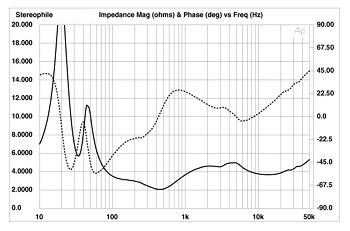
In the above graph, the solid line represents impedance and the dashed line represents phase. Frequency is measured on the horizontal axis in Hz. Impedance is measured in ohms on the left vertical axis. Phase is measured on the right vertical axis in degrees.
It is clearly seen that the impedance of the measured speaker varies significantly with frequency. It is interesting to note that the nominal impedance of this speaker is 8 ohms, despite the fact that for high peaks its impedance is less than 4 ohms.
What are phase angles?
It's also worth discussing the phase measurement in the graph above. Phase is measured in degrees. The greater the angle in the positive direction, the more inductive the speaker becomes, the greater the angle in the negative direction, the greater the capacitance. The above speaker phase angles are actually not as steep as some others we've seen, but one important consideration is that the speaker is quite capacitive at about 80 Hz, where the speaker's total impedance is about 4 ohms. The combination of low impedance and high capacitance requires the amplifier to generate large amounts of current at this frequency.
What do the lamps want?
Lamps love resistive loading - it really is that simple. A resistive load means even impedance and inductive rather than capacitive phase angle. A less technical view of the ideal speaker from a tube perspective is this: tubes like consistency. They prefer a speaker that doesn't sag from 8 ohms to 2 ohms (and then back again). If the impedance drops, it should do so gradually or in small peaks. Lamps like a constant load - capacitance is the opposite of that. When a speaker behaves in a capacitive manner, it creates an uneven load on the amp, requesting current at sudden spikes. Lamps don't like to pump current in at short notice. They prefer a constant and predictable load.
In reality, speaker manufacturers sometimes find it difficult to keep all of the above variables within ideal ranges. If the phase angles are to be capacitive, the impedance must be high. The lower the impedance, the flatter it must be and the less capacitive the phase angle must be. All three variables (impedance curve, impedance value, phase angle value) together determine how well the speaker will match the tube amplifier.
For this reason, the argument that only speakers with an impedance of 8 ohms or higher will work on tubes is incorrect. There are many "tube" speakers with a nominal impedance of 4 ohms. If the speaker impedance is relatively flat and constantly oscillates around 4 ohms, and if the phase angles are only slightly capacitive, or better yet, inductive, there is no reason why a 4 ohm speaker will not work well with a tube amplifier. Some of our favorite "tube" speakers are just right at 4 ohms! It's also important to realize that there is no need to use 4 ohm outputs on a tube amp with 4 ohm speakers. Many 4 ohm speakers sound best when connected to 8 or even 16 ohm outputs. If the speaker has a resistive load (i.e., even impedance - even if it's low), then the 8 or 16 ohm outputs will work fine and will always sound better than the 4 ohm outputs. If the speaker requires more current because the impedance is low and not very even, connecting to 4-ohm outputs will likely give better bass control at the cost of reduced treble and midrange resolution. We recommend that you try your speakers on each of the outputs to hear the difference.
If the above explanation seems complicated, let's look at a few more graphs. Visualizing our explanation will make it much easier to understand. Let's start with some graphs of columns working great with lamps.
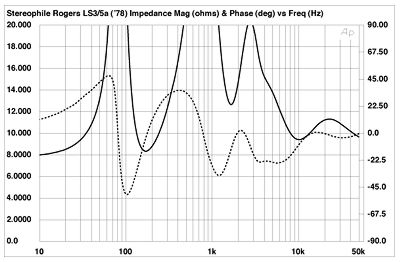
The above graph is for the Rogers LS 3/5a, well known for its combination with tubes. While the impedance is not flat, it is consistently high, never dropping below 8 ohms and often peaking above 20 ohms. As a result, it requires less current from the amplifier. At the same time, the phase angles for this speaker are only slightly capacitive, except for a dip at around 110 Hz. However, note that the corresponding impedance is extremely high, which somewhat reduces the effect of capacitance. This behavior (increasing impedance while the phase angle is decreasing) is found in many tube friendly speakers. Remember our discussion of sensitivity and how it can be misleading? The sensitivity measurements of the Rogers LS 3/5a are 82 dB/watt. Nevertheless, these are among the most suitable of any loudspeaker ever designed for use with tubes. The Rogers LS 3/5a is one of our industry's best examples of a low-sensitivity, high-impedance speaker with relatively soft phase angles that are perfectly matched to tubes.
Let's look at the other column:
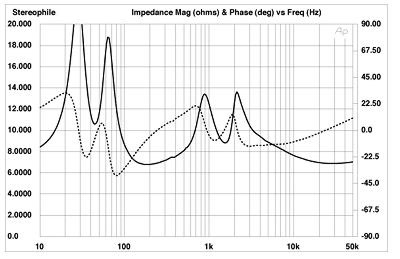
Above is an impedance plot for another very tube-friendly loudspeaker (sensitivity is published as 86 dB/watt). Again we see a trend toward consistently high impedance. This speaker is nominally rated at 8 ohms, and its impedance never drops much below 6.5 ohms. The phase angles of this speaker are even better than the Rogers, with one small dip at around 80Hz showing less capacitance than the Rogers, and again we see that the corresponding impedance is quite high.
Now let's try a speaker with a lower impedance:
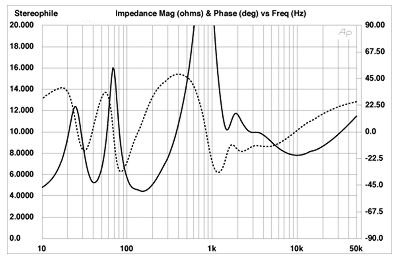
This speaker has a nominal impedance of 8 ohms, which may be a bit optimistic, but nevertheless it briefly dips below 6 ohms a couple times, and when it does, the phase angles are either slightly capacitive or inductive.
Now let's look at some "anti-lamp" impedance graphs:
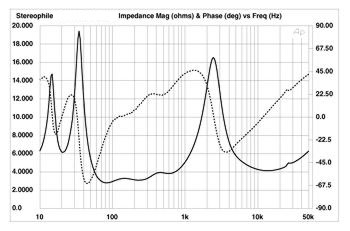
Here we see a speaker whose nominal impedance (8 ohms) bears no relation to its actual impedance. Over most of the audible bandwidth range, this speaker shows less than 4 ohms. Moreover, around 55 Hz we see a very steep capacitive phase angle that intersects with the low impedance. Combined, these two factors place very significant demands on the amplifier. And this speaker has a published sensitivity of 91 dB/watt! Is it now clear how deceptive sensitivity can be in selecting a tube-friendly speaker? Of all the speakers discussed above, the speaker with the best sensitivity proved to be the worst for tube applications.
Here's another guy who doesn't play well with a lamp:
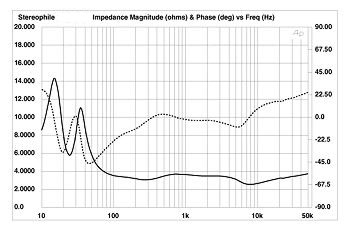
In this case, the problem is really quite simple - the measured impedance for this speaker is unrealistically low across most of the spectrum. From 80 Hz to 50 kHz, this speaker shows less than 4 ohms, and drops to 3 ohms at some points. While its phase angles are relatively harmless, the impedance is so low that only a high inductive load will make a difference. This speaker requires an amplifier that is tolerant of very low impedance, capable of outputting large amounts of current on demand.
Let's take a look at another chart:
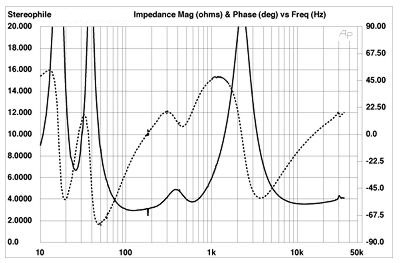
In this example we see an impedance that mimics a roller coaster - up, then down, then up, then down again. The giant peak between 1 and 5 kHz, on either side of which we see impedance of less than 4 ohms, guarantees unstable tube operation. As in the previous examples, we also see a relatively capacitive phase angle intersecting with a fairly low impedance, requiring high amplifier output current.
What is the inverse electromotive force (EMF)?
Reverse EMF is the kind of variable that is difficult to measure from impedance plots, but it makes a significant contribution to how tube-friendly a given driver will be. Think for a moment about how a speaker works: the amplifier excites the driver of the speaker by sending it current. Now look at the process in reverse: if you excite the driver of the speaker (for example, by gently pushing on it), you send some current from the speaker to the amplifier. You've just reversed the direction in the circuit. Reverse EMF can be considered in this context.
Thus, when the amplifier sends current to the speaker and the speaker driver moves, the current returns from the speaker to the amplifier. Mathematically, the amplifier sees this current as negative because it flows in the opposite direction to the current the amplifier is sending to the speaker. The easiest way to visualize back EMF is to associate it with a net reduction in speaker impedance.
Reverse EMF is most pronounced with poorly damped woofers. As a result, if a speaker sends more EMF back to the amplifier, it usually does so at low frequencies, since it is at low frequencies that the driver peaks in oscillation. This is why it is so common to find speakers that work well with tubes, until you put in a recording with a powerful bass, at which point the driver stumbles and the sound deteriorates rapidly. This is just the result of low frequency excitation of a large flexible (floppy disk-like) driver, which in turn generates back EMF and reduces impedance.
This is why trial and error is necessary. Just looking at the impedance graph does not always guarantee that the speaker will fit the tube. The impedance graph does not show the effect of back EMF because it varies considerably depending on the musical material used.
At the risk of repeating ourselves, just as we cannot judge the quality of a speaker by looking at its impedance graph, we cannot judge its sound based on how much back EMF it generates. All of the variables we've discussed in this article are simply related to how tube-friendly a given speaker will be, and therefore how well it will sound with a tube. A speaker with low impedance, high capacitance, and significant back EMF can sound incredible with the right amplifier. But an important consideration in optimizing the sound of this speaker will be to choose an amplifier that can adequately meet the demands placed on it by such electrical characteristics.
Transistors can be finicky too!
Let's discuss transistor amplifiers for a moment. It is important to realize that all of our discussion of impedance and back EMF applies to all amplifiers, not just tube amplifiers. Not all transistor amplifiers are well suited for speakers whose impedance falls below 4 ohms. Some amplifiers use what is called "current limiting" circuitry: the less resistance the speaker imposes on the amplifier, the less current it receives. For many amplifiers, the output current is limited to a load below 4 ohms. Essentially, this means that a speaker whose impedance falls below 4 ohms for a significant portion of the audio spectrum will not be engaged to its full potential by a current-limiting transistorized amplifier. This is why, in our discussion of sensitivity, we pointed out that high sensitivity does not guarantee that a speaker will play loud, even if it is powered by a transistorized amplifier. With an extremely low impedance speaker connected to an inappropriate transistor amplifier, you will find that up to a certain threshold it will not play at all, regardless of sensitivity.
Which amplifiers are current limiting? This is a question that a salesperson should be able to answer, and if not, then of course the amplifier manufacturer. The reason why so many cheap receivers and amplifiers are unable to reproduce deep bass is that they have current limiting circuitry that prevents them from transmitting low frequencies at low impedance. Consequently, when connected to low impedance speakers, especially at low frequencies, these receivers or amplifiers will produce flimsy bass.
But this is not necessarily a bad sign: many excellent transistor amplifiers use current limiting circuits. Choosing the speakers that will sound best on a current-limited transistor amplifier is similar to choosing speakers for a tube amplifier, although in this case you don't have to be so rigid in your selection criteria. Generally, transistor amplifiers, even those with current limiting, are more tolerant of high capacitance than tube amplifiers, and large impedance drops are less important if the minimum impedance remains above a reasonable value such as 4 ohms. Reverse EMF does not tend to bother a transistor amplifier unless the speaker itself is low impedance and sends a significant amount of reverse EMF into the amplifier.
For those speakers that present more complex loads with extremely low impedance, transistor amplifiers using "current damping" circuitry should be selected. Current damped amplifiers continue to deliver more and more current until the impedance becomes vanishingly low. Typically, such amplifiers will only shut down if there is a short circuit or if thermal instability is reached.
We <in the store> have both solid-state amplifiers with damping and current limiting, so when a customer wants a tranisistor amplifier, we try to choose the right one for their speakers.
How do I know if it plays with the lamp or not?
You can easily tell if a tube speaker sounds bad if you ... listen to it! Of course, we recommend that you learn as much data as possible so that you don't waste time listening to obviously ill-fitting tube options, but when it comes to making a choice, the only way to find the right speaker is to listen to it. The sound of a poorly matched speaker when connected to a tube amplifier is usually characterized by one or more of the following sonic characteristics:
- Dual mono image, i.e. speakers do not "disappear"
- Unusually weak cues or stage
- Lumpy, bloated or "one note" bass
- Lack of bass control - excessive lushness or puffiness
- Failure in the midrange
- Whenever the bass kicks in, the midrange goes away
- Whenever the bass kicks in, the highs become harsh and tense
- When you connect the speaker to a transistorized amplifier, the bass becomes more collected, the mids return, and the highs soften
The above traits are especially pronounced on single-cycle triode amplifiers. Some speakers are push-pull friendly, but not single-cycle friendly. Two-cycle amplifiers, even with low power ratings, can generally handle more demanding or capacitive loads than single-cycle amplifiers. If in doubt, listen to the amplifier and the speakers you plan to pair before you buy.
Concluding remarks
As you can see, understanding the measurable characteristics of audio equipment is fundamental to building a good Hi-Fi system, whether you plan to use a tube or transistor amplifier. It is difficult to make generalizations about the quality of a given speaker or amplifier in terms of its measurements alone. There are many great speakers that are extremely high load for an amplifier and just don't come close to a tube. On the other hand, there are speakers that are easily driven and are a mild load, but may not be the best examples of speakers to be found in our industry. As has been discussed in magazines and forums for years, you can't make a simple correlation between measurements and performance. However, we believe that to ignore measurements is to limit the performance of one's equipment.
You can always choose the amplifier of your choice in the Papatube audio
